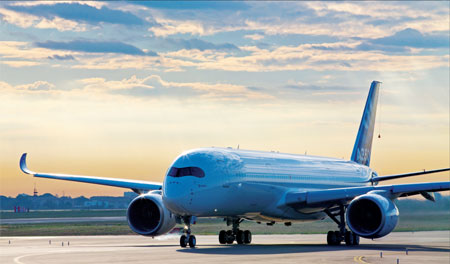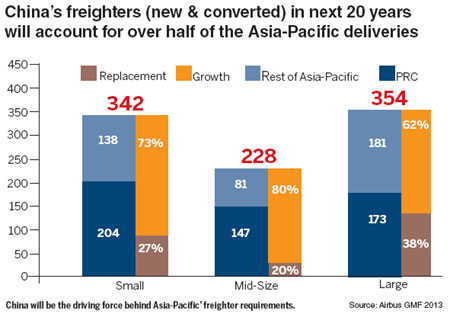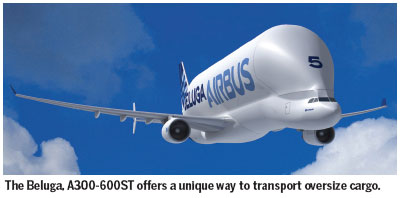Loads of Optimism
Updated: 2013-10-25 06:53
By Wong Joon San(HK Edition)
|
|||||||||
As confidence returns to the troubled air cargo business, industry leaders see brighter prospects ahead, with French aircraft-manufacturer Airbus gearing up for heavy demand. Wong Joon San reports.
By the middle of 2013, air cargo accounted for no less than 30 percent of Cathay Pacific Airways' annual revenues of $3.2 billion. Cathay and its sister airline Dragonair had helped to build Hong Kong into one of the world's busiest business air-cargo hubs.
What's remarkable about those figures is that Cathay and Dragonair, remained focused on their core business, passenger travel, until the late 1990's. With globalization, demand for air-cargo services shot up, only to come crashing down, along with passenger services, after the 9/11 terror attacks in 2001 in the United States.
After reaching a peak in 2,000, the aviation business practically fell apart in the wake of 9/11. Some airfreight - comprising mainly air cargo and mail - went maritime to reduce costs.
While global trade and commerce took a severe beating worldwide, fuel prices paid by airlines began to soar. Between 1980 and 2000, the benchmark Brent crude oil price hovered around $30 per barrel (bbl). By 2010, it had shot up to about $80 per bbl. Now, it's around $100 per bbl, and is expected to rise to slightly more than $100 per bbl by 2020, and $130 per bbl by 2030.
A series of crises like severe acute respiratory syndrome (SARS), H5N1 bird flu, and the 2008 global financial crisis played a part. The air cargo market was hit badly. On the other hand, Hong Kong, by drumming up its flexibility, creativity and connectivity, came through the trials in good shape.
Cathay Pacific admits that its current cargo business is lackluster, but the carrier hopes fourth quarter numbers will improve on the strength of positive seasonal demand at Christmas, coupled with the US economic rebound.
Cathay says freight demand has been low for three years and it's eagerly anticipating an improvement in market conditions. If the global economy improves, cargo and passenger flow will fare better in the second half.
Analysts say the economies of North America and Europe are showing signs of coming out of the economic downturn.
Dark chapter
There were also some dark times after the Australian Competition & Consumer Commission (ACCC) started investigating collusion on fuel surcharges among air cargo services. The allegations covered the time span from 2000 to 2006. Since the launch of proceedings in 2008, 13 of 15 international airlines have paid penalties of A$98.5 million ($95.2 million) up to the end of last year for rigging rates on international air routes. Qantas paid $20m. Emirates Airways, A$10 million; Singapore Airlines, A$11.75 million; Cathay Pacific, A$11.25 million and Thai Airways International, A$7.5 million, for their part in the collusion on rates on international routes.
The industry is finally recovering from that embarrassment but still, it faces challenging conditions that show no sign of abating.
What is surprising is that all this is happening as online shopping is creating a boom in parcel freight and e-commerce, with some dedicated air-cargo operators reaping the rewards.
Airbus market forecast
According to the Airbus Cargo Global Market Forecast 2013-2032, world trade is set to double by 2032, to 540 trillion. Air cargo trade over the next 20 years will be worth $180 trillion, and it is forecast that emerging countries trade will almost triple in the next two decades.
Airbus forecasts that traditional air cargo trade links will diversify even more.
China will be the driving force behind Asia Pacific's freighter aircraft requirements over the next 20 years, and the country will account for over 50 percent of all Asia Pacific freighter aircraft deliveries.
Andreas Hermann, Airbus' vice -president freighters, who presented the forecast in Hong Kong recently, says the region will need 342 small freighter aircraft, 228 mid-size freighter aircraft and 354 large freighter aircraft in the form of new aircraft and old passenger aircraft conversions into freighter aircraft over the next 20 years.
Of the figure, China will take up 204 small freighter aircraft, 147 mid-size and 173 large freighters, Hermann said, adding that 80 percent of mid-size freighter aircraft demand will be driven by Asia-Pacific economic growth and Chinese trade and commerce. Traffic to the rest of the world that is set to grow 6.6 percent year-on-year. Domestic Chinese trade and commerce traffic growth will be 7.5 percent year-on-year.
Hermann says that in the next two decades, freight ton-kilometer (FTK) growth will be 4.8 percent, with a total of 2,730 freighter aircraft deliveries, including 871 new planes. The business volume for new freighter aircraft in the next 20 years will be worth $234 billion, and the future proportion of small-sized freighter aircraft will be 22 percent, mid-size freighters 45 percent and large freighters 33 percent.
Asked about the challenge to freighter aircraft from cargo transported in the belly-hold of passenger aircraft, Hermann says certain factors governing passenger aircraft would constrain passenger jets from carrying heavy freight. He cites, departure and arrival times, range limitations of cargo, whether destinations are cargo or tourist destinations and the type and size of cargoes. "As a result, passenger belly load factors will not exceed 40 to 50 percent (of total air cargo tonnage worldwide)," he says.
David Prevor, head of market research and forecast at Airbus, says: "Thirty-three percent of all freighter aircraft in 2032 will be domiciled in Asia-Pacific and 80 percent of demand for mid-sized freighter aircraft driven by Asia-Pacific growth."
Asked about the price difference (at today's prices for) new freighter aircraft, comprising small, medium and large freighter aircraft, compared with conversions of passenger aircraft to cargo freighter aircraft, Prevor said a new A330-200F aircraft costs $219 million, while conversions really depends on which company does the conversion.
"Mid-sized freighter aircraft such as the A330-200F cater for the bulk of demand (about 45 percent) for cargo aircraft in the next 20 years.
"Airbus' Cargo GMF sees a demand for 2,700 new and converted cargo aircraft between now and 2032. Of these, 871 (413 mid-size and 458 large freighter aircraft) will be newly built aircraft. The remaining 1,850 will be conversions (824 mid-size freighters and 430 large freighters)," Prevor says.
Hermann says that today's large freighter aircraft can only work on the heaviest trade lanes. "Large freighters need high demand and high payloads all year. Mid-size freighters are more efficient when fuel, demand or yields fluctuate."
As the global economy changes shape, airlines must adapt their capacity and network, he says.
Contact the writer at joonsan@chinadailyhk.com



(HK Edition 10/25/2013 page6)